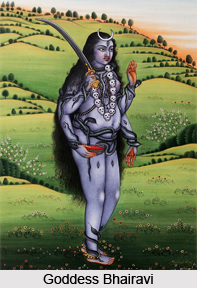 Goddess Bhairavi is one of the goddess of the Ten Mahavidyas is a violent and terrifying aspect of the Devi that resembles Goddess Kali. Bhairavi represents the supreme power of speech, which has the nature offire. Her rage is directed towards the negative forces of the life. She is the supreme light and heat power.
Goddess Bhairavi is one of the goddess of the Ten Mahavidyas is a violent and terrifying aspect of the Devi that resembles Goddess Kali. Bhairavi represents the supreme power of speech, which has the nature offire. Her rage is directed towards the negative forces of the life. She is the supreme light and heat power.
Goddess Bhairavi dwells in the base chakra that is Mooladhara Chakra whose role is the purifying agent before a sadhaka ascends to god communion. She possesses the effulgence of a thousand rising suns. She represents victory of light over darkness or ignorance. She manifests herself in threefold form in the material universe Fire (Agni), Lightning (Vidyut) and the Sun (Surya).
Origin of Goddess Bhairavi
Bhairavi indicates the supreme word also known as "Para Vak". Thus she is subtler than and is the origin of Goddess Tara. It could be said that as Tara becomes Bhairavi the illumined word turns into supreme light and heat. Goddess Bhairavi is the consort of Bhairava, which is the fierce form of Lord Shiva. Bhairava is also known as Rudra hence the goddess is known as Rudrani. She is also called "Shubhamkari", "Baala" or "Tripurabhairavi".
Iconography of Goddess Bhairavi
The goddess holds a book, rosary and makes fear-dispelling and boon-conferring gestures. Bhairavi has a glowing complexion and is adorned with silken red clothes and a garland of severed heads. The goddess has three eyes and on her forehead she has a half moon. Her head is decorated with a stone studded crown. She wears red clothes and carries a trident, small drum, arrows and bows. The goddess is seen seated on a corpse throne.
Legend of Goddess Bhairavi
According to legend, when Goddess Bhairavi approached the battle field, her ghastly appearance made the demons weak and very frail. Bhairavi has been regarded as Chandi in the Durga Saptashati version when she killed the two demons Shumbha and Nishumbha. She kills and drinks the blood of Chanda and Munda the Chieftains of Asuras, so the Goddess Parvati gives her a boon that she would be called "Chamundeshwari". The goddess has also been acknowledged to represent the forms of Goddess Parvati and Goddess Durga. When furious, she is found sitting on a faithful donkey, with her mouth full of blood of the demons. The body remains covered with a tiger skin and skeleton. She also presents the Abhaya Mudra and Varada Mudra, and she is shown holding weapons such as a trident, axe, and thunderbolt.
Worshipping of Goddess Bhairavi
Bhairavi as "Tapas" is worshiped by those who wish to seek knowledge. She provides control of the senses and the emotions. Her power of divine speech and spiritual fire eliminates all obstacles. Worshipping Goddess Bhairavi can really prove to be beneficial. Performing the following Bhairavi Mantra chanting before an image of Mata Bhairavi tends to drive evil forces, inviting positive and healthy vibes.




















